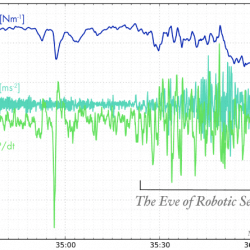Desire for Casual Sex May Predict Less Interest in Sex Robots
Findings suggest interest in robotic love dolls is about more than sex.

Does a desire for casual sex mean a robotic lover will never enter your bed?
According to results from my research on desire for robots, it’s mostly likely the case that someone who seeks multiple casual sex partners is not also fantasizing about sex robots.
On its face, the finding could also be easily interpreted to support stereotypes about why people desire robots. Yet upon closer examination, I contend this finding supports the notion that people may be interested in sex robots for reasons aside from casual sex.
For the love and desire of robots
Over the past few articles, I have discussed findings from my thesis that examines individual differences in desire for intimacy with robots. In one article, I discussed how hostile sexism is one reason that men might be interested in having sex with robots. In another article, I focused on the need for diversity in sex robot development so that robots can appeal to a greater variety of people. And lastly, I discussed a finding that men are more interested in sex with robots, while women are more interested in friendship with robots.
In this article, I will share my findings when I measured a person’s desire for robots along with their sociosexual orientation (SOI).
What is sociosexual orientation (SOI)?
In simpler terms, sociosexual orientation (SOI) is someone’s likelihood of engaging in or desiring casual sex with another person. SOI also examines someone’s beliefs about casual sex, such as their agreement with the statement “sex without love is okay”.
In order to determine a particpant’s SOI, the team asked participants about about their engagement in casual sex in the last year, if they think that casual sex is something they would be interested in (e.g., “sex without love is okay”), and if they have had any desire toward casual sex with a friend, or a stranger, in the past week, two weeks, or month.
In my thesis, I found that, for both men and women (in a sample of undergraduate students at a pacific northwestern university), higher SOI (more interest in casual sex) predicted less interest in sex with a robot. Stated another way, in a measure that combined behavior, attitude, and desire of individuals toward casual sex with people, higher scores predicted less interest in robots.
Casual sex and robots
The most obvious answer is that people who have more casual sex may be less interested in sex robots. This also suggests that people who have less casual sex may be more interested in sex robots. While this might fit a number of preconceived notions about who is interested in sex robots, there is a lot of nuance worth explaining.
First, actually having causal sex is only one of the three facets of SOI, and the other two relate to wanting casual sex.
A higher SOI is possible if someone reports having frequent sex while hating casual sex as a concept, and having zero desire for it. Yet, people with higher SOI can be considered more sex-focused people compared to those with lower SOI.
If someone wants casual sex a lot and has had zero partners in the last year, they could still have relatively high SOI scores.
And, to clarify some of these findings, while analyses can be done of the facets separately, it is often not a valid use of the measure to draw conclusions from the facets individually.
What this finding suggests is that people might be interested in sex robots for reasons aside from casual sex.
When someone spends money on a sex robot, the buyer may consider it a commitment, and that commitment may instead resemble a relationship rather than casual sex. I contend that, instead of the obvious “sex robot lovers have no sex” notion, people who use sex robots may not interested in casual sex at all, and instead may want a relationship.
This creates a future direction for this research, which could examine how much participants want a committed relationship compared to sex, and if that belief relates to interest in a robot for sex and/or relationships.
Although there is no immediate timeline for this research, it can be supported by keeping in touch with us at Future of Sex, and supporting conferences like the yearly Congress on Love and Sex with Robots.
Image source: Maru Lombardo

















